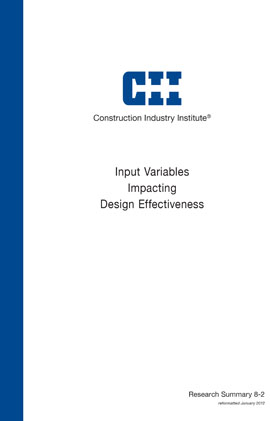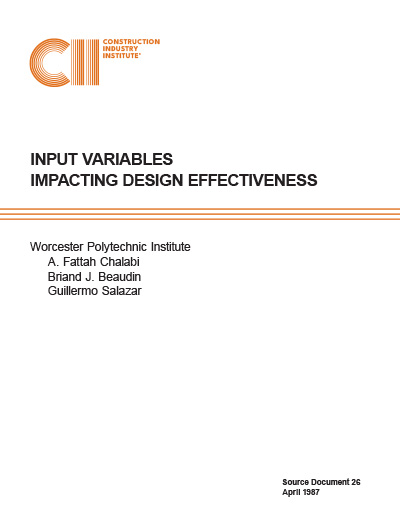
Objectives Matrix Values for Evaluation of Design Effectiveness
This report presents data collected from a substantial number of industry projects in an attempt to recommend guidelines for the selection of weights and benchmark levels of design performance for different project scenarios. The construction and the mechanics of an Objectives Matrix have been discussed. The research methodology has been discussed presenting the method of data collection. The subjective measurements have been presented and some suggestions have been made to change the subjective measurements to quantitative measurements. The weights and the benchmark levels have been presented. Measured project values were presented for normal average projects. Project variables have been considered. The variables have been compared and discussed and the significance of the variables to the sub-criteria have been determined. Adjustment factors have been presented and a method for modifying the benchmark levels of performance and the performance indices has been discussed. Suggested values for the benchmark levels and the weights for the design criteria and sub-criteria have been presented. This final chapter presents conclusions and recommendations to this report.
Conclusions
- Meaningful weights for the established piping criteria and sub-criteria have been presented.
- Weights have been divided into the owner, designer, and constructor viewpoints since they differ as to which criteria and sub-criteria have the most impact on design effectiveness.
- Meaningful benchmark performance levels for total projects and dividing into project variables have been considered.
- Adjustment factors were derived from project data collected from thirty-one projects and presented for each of the project variables.
- A method to modify benchmark values and the performance index to conform to different project scenarios using adjustment factors was presented. Adjustment factors corresponding to each project variable are multiplied by the suggested benchmark value or by the performance index that is to be modified. This allows projects with different scenarios to be compared. The adjustment factors are for the most part close to one and only need to be used when more accuracy is required or when a unique project is being considered.
- The significance of the project variables to the sub-criteria has been determined and presented.
- Suggestions for future sub-criteria quantifiers to be used when evaluating piping have been presented thus eliminating some of the subjective ratings.
- Ratio measures provide a better means of evaluating the criteria than do subjective ratings. The performance indices derived from subjective ratings may be misleading due to the high subjective ratings.
- Suggested values for benchmark levels and weights for the design criteria and sub-criteria were presented for use as a "base-line" from which an Objectives Matrix may be created.
Recommendations
The following are recommendations to be considered for future use of the Objectives Matrix:
- More data needs to be collected for piping to increase the credibility of the adjustment factors.
- Collect data from different phases of a project other than piping (for example, civil, electrical, mechanical, structures, etc.). Or possibly collect data for the project as a whole.
- Investigate different industries for use of the Objectives Matrix (for example, consider commercial or residential work).
- Minimize subjective ratings.
- Investigate other uses for the Objectives Matrix. Using the Objectives Matrix as a decision analysis tool, as a tool for incentives, or as a tool for project cost estimation are some possibilities for consideration.



